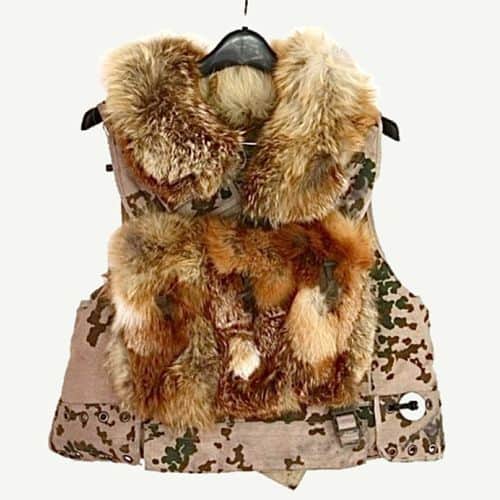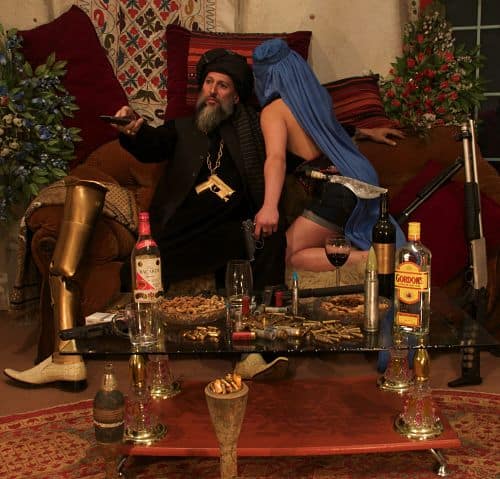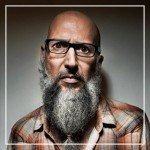In this essay, Afghan American artist Aman Mojadid reflects on a series of installations entitled “Conflict Chic” he exhibited in a solo exhibition in Paris in 2011. He discusses the imagined geographies born out of the Afghan wars and the search for a post-Orientalist tradition in the post-9/11 era. Read part 1 of his essay here.
Since the end of the Second World War and the appearance of a so-called Third World, academics and geopoliticians began speaking of ‘postcolonialism’, as if by becoming self-governing nations that were no longer politically ruled by western powers these places were now somehow independent (or indeed free from) their unequal relationships with their now former colonizers. The reality is very different. After years of exploitation, including that of human and natural resources, the newly ‘independent’ countries went from being politically oppressed to being economically dependent, and the relationships simply shifted from the governmental realm to the financial one where loans were dispersed by former colonizer (Eurocentric) countries to formerly colonized (Othered) nations that ensured their ongoing dependence and guaranteed that their politicians would make policy decisions favourable to their former colonizers. As a result, these restructured relationships did not facilitate the kind of transformation necessary in order to move beyond the colonial mindsets that perpetuate unequal political and economic dynamics between nations of the colonizer and colonized. Instead, the struggle for liberation from control by Eurocentric nations has continued over recent decades, and therefore the attitudes that shaped pre-Second World War relations can still be found not only in political and economic circles, but in artistic and cultural ones as well.
This then brings us back to the discussion of how we can truly create a Third Space, as opposed to a Third World, in order to achieve the liberating state of a post-Orientalist condition. What would it look like if or when we did create it? Of course, we are not talking about a space in the traditional sense, with walls, limits and boundaries. Quite the opposite in fact – we are talking about a space that erases borders, blurs identities and levels inequalities; or a space where those ‘unequal and uneven forces of cultural representation’ are made equal and even (Bhabha 1994). The challenge is how such a space can be made lasting, a more permanent space where these new, restructured and more egalitarian relationships can continue to exist, to grow and to disrupt previous power dynamics. For in the world today,
the possibility of a Third Space is still limited by its impermanence, by its predictable dissolution resulting in large part from the resistance of Eurocentric-dominated structures and institutions to facilitate such lasting changes.
But the reality is that no matter what kind of resistance these actors may have, the changes themselves could very well be inevitable. As the shared experiences within Third Spaces increase, without oppressive relationships and where the particularity of individuals, in fact the complex hybridity that makes up the post-Orientalist person, rises above the stereotyped collectivity of entire peoples and places rooted in older models of Orientalism, it will become less and less likely that the oppressed or Othered will accept a return to their previously imposed inferior position. This unwillingness could be the spark that ignites a revolution of sorts in the way that the arts and artists of the Othered engage, and/or are engaged, within the global art world of exhibitions, institutions and markets.
When looking at societal class struggles throughout history, there is always a dominant class that is then challenged by the dominated in an attempt to bring about greater equality between classes. What I am talking about in terms of the possibilities that a Third Space could provide to Othered artists is in much the same vein as a class struggle, whereby Othered artists could in essence rise up against those who dominate the art world and demand greater equality in terms not only of access to but ownership of the production, dissemination, interpretation, exhibition, etc. of Othered art and artistic activity on a global level. In the same way that sources of capital are controlled by the dominant economic class, the sources of Third Spaces today where Eurocentrics and Othered artists interact are also still largely controlled by the Eurocentrics. Therefore, in order to achieve a truly revolutionary use of Third Spaces, the response would then include, and indeed necessitate, the increased participation of Othered curators, galleries, museums, collectors and institutions that, through their experiences in Third Spaces, establish their own artistic structures to challenge the dominant paradigms of today.
An example of just such an Othered institutional response is the Palestinian Museum which opened in May 2016. It has been developed as an institution that will ‘act as a dynamic, innovative forum for the exchange and development of knowledge and ideas’ and, furthermore, ‘be capable of transcending political and geographical borders, resisting the social divisions and restrictions to mobility imposed by the Israeli occupation . . . to resist the ghettoization and fragmentation of the Palestinian people’ (The Palestinan Museum 2015). Many involved with developing the museum project have been otherwise engaged in Third Space experiences for some time through the many Biennales, fairs, etc. that make up the international art ‘scene’. As mentioned before, these interactions and experiences can serve as the foundational potential for ambitious revolutionary projects such as the Palestinian Museum.
However, as with the museum, the new knowledge structures formed through Third Space interactions are not, in and of themselves, enough for this ‘revolution’ of sorts to reach its full potential across conflicted countries of the Othered. Another crucial component will be access to, and sources of, funding. All artists and institutions, anywhere in the world, look for funding to help realize their projects and exhibitions. But it is a fact that most sources of funding still come from Eurocentric individuals and institutions, with their own perspectives and agendas when it comes to Othered art and artists. This brings us back to the issue of the art market, and how Eurocentric institutions continue to hold the upper hand when it comes to funding Othered art, artists and institutions. Even with the Palestinian Museum, one sees many Eurocentric institutions serving as funding sources. Therefore although the museum has transcended certain Eurocentric constructs in its establishment, it still may potentially face some of the restrictions and/or limitations that come with Eurocentric funding structures. Othered artists and institutions, therefore, when looking for funds from Eurocentric sources, might be limited in terms of what kind of work or project they could get funding for because it may or may not fit what the Eurocentrics expect of them.
It will therefore be necessary for Othered countries to also invest significantly in their own artistic and cultural futures.
The investment should come from several sources, including governmental ones such as culture ministries and foundations for the arts, and the private sector. With this sort of investment, Othered art and artists will be able to free themselves from economic dependency on Eurocentric art structures and institutions. If this funding came from their own countries, there could very well be a more supportive synergy between funder and funded. This is not to say of course that Othered artists and institutions from conflicted countries (or any country for that matter) should only get funding from their own nations, but it is to say that if the sources of funding were more widely dispersed between the Eurocentrics and the Othered, then there could also be a more disseminated degree of control over the artistic and/or institutional production. One example of such an initiative can be found in the Samdani Art Foundation in Dhaka, formed by Bangladeshi entrepreneurs as a platform through which to support and promote contemporary art from Bangladeshi artists.
Therefore it is important that the Othered begin to create Third Spaces as well, so that these spaces are not only initiated by Eurocentrics. Whether they are exhibitions (such as the Dhaka Art Summit created by the Samdani Art Foundation), exchange programmes, collaborative projects, etc., by doing so the Othered will be able to further facilitate a new power structure both within these Third Spaces and outside of them. The experiences then had within Third Spaces could very well contribute to not only realizing a new economic model as discussed above for funding Othered artists and institutions, but also new knowledge structures that then ultimately can create more egalitarian power structures as well. Although not by any means self-evident, I argue that it will only be through these various Third Spaces that the Eurocentric-dominated field of arts in the global arena, particularly the recent popularity of Othered art and artists from conflicted countries in Asia and the Middle East, can be dismantled, reshaped and re-established in a more egalitarian form.
I have tried in this chapter to explore the complexities of a renewed interest by Eurocentric art circles, including galleries, museums, curators and institutions in Othered art and artists from conflicted countries in Asia and the Middle East. Not an easy task, nor one that I pretend to have made less complicated nor any less convoluted. It is a sticky mess when attempting to untangle the threads of history and their impact on our relational structures today. Furthermore, attempts at bringing about a sort of Derrida-esque deconstruction of Eurocentric assumptions regarding their own power in respect to Othered art and artists from conflicted countries is neither straightforward nor without its own set of limitations.
Perhaps this is why the concept of a Third Space is the most relevant here.
What a Third Space does is take the disproportionate nature of the relevant power relationships and provide an opportunity to reset it so that the different actors, the Eurocentrics and the Othered, can play more equal roles in the construction of the relationships within that space.
But, more importantly, it is through the Third Space that Eurocentrics and the Othered alike can accept each other in new ways, and then carry those new ways of understanding and interacting outside of the Third Space and embed them into the everyday spaces of their lives.
But it is more than simply the will to do so that is needed. Eurocentrics must acknowledge the lingering forms of stereotyping and dominance that continue to colour their attitudes and approaches towards Othered art and artists from conflicted countries. They must realize that the burden is no longer (in fact never was) theirs to bear when it comes to ‘discovering’ Othered artists or introducing their work to the world. Simultaneously, Othered artists, curators and institutions must understand that although there is much that can be learned from, taught to and shared with the Eurocentrics through interactions within the Third Spaces of art exhibitions, Biennales and so on, it is not necessary to simply shape themselves into the particular mould that may be expected of them. Instead, the Othered should create work, projects, exhibitions and institutions that tell the stories they want to tell, in whatever voices they want to tell them.
There are no quick or easy solutions to the complexities inherent in this new vigor with which Eurocentrics are pursuing Othered art and artists in conflicted countries of Asia and the Middle East. I have attempted to shed light on some of the issues, as well as on possible paths through which these issues could be dealt with. Some may argue with me that I am being too judgmental, or putting too much into the situation by referencing colonialist structures and attitudes that in theory at least have not existed for decades. But I would beg to counter by referencing simply that just because there was a civil rights movement that resulted in a Civil Rights Act in the United States does not mean that racism, and its effects on the lives of black Americans, has disappeared.
However, with all of the now more complicated structures apparent in the art relationship between the Eurocentrics and the Othered, it is of course impossible to imply that there has been no loosening of the grip on power that has been historically held by Eurocentrics over the Othered. We also cannot say that Othered artists who come from conflicted countries of Asia and the Middle East are always and inevitably at the mercy of Eurocentric prejudices and agendas. Reality is never black and white, and it is true that today there is perhaps more grey, largely in the form of Third Spaces, found in the world than ever before. And this is likely to continue. But this is not a natural state of change. Rather, it is the culmination of the actions of many individuals, collectives and institutions – artists, curators, foundations, museums − who have, through the existence and experience of Third Space exhibitions, programmes, conferences, etc. disrupted the status quo and forged new relationships between the Eurocentrics and the Othered.
Will these new relationships last? Will the shifting power structures continue to challenge old models and help bring about a more not only global, but globally representative, art world? These are difficult questions to answer as they require the ability not only to be optimistic, but also to trust that the art world is perhaps made from a different kind of material in comparison to other Eurocentric/Othered relationships we might find both historically and today; a material that is more malleable, more willing to take new forms.
We must also be willing to acknowledge that art, and the international space it inhabits, is perhaps the one vehicle through which these old relationships can be altered − a space where political acts such as this can, through their abstraction, not only reach a wider audience but also transcend the banality of historical limitations when it comes to defining this relationship.
The Othered artists from conflicted countries will no doubt continue to seek a more equal playing field, positioning themselves as serious artists with the will to work on the global level, rather than some form of endangered species in need of being saved and paraded internationally through a variety of venues. But it is still within these venues, as well as the ones that will be created by not only the Othered artists themselves but also Othered curators, institutions, and so on, that will provide the necessary Third Spaces where the traditionally oppressed and oppressor can reset the terms and forms of their engagement. By doing so, conflict could cease to be chic; entire places and peoples could cease to be homogeneously exotic; and the Othered could find themselves at the end of the search for a post-Orientalist condition.
Perhaps then the Othered would no longer need to whisper in the corners of taverns and bazaars.
References
Bhabha, Homi, The Location of Culture (Abingdon: Routledge, 1994).
Escobar, Arturo, Encountering Development: The Making and Unmaking of the Third World (Princeton: Princeton University Press, 1995).
Kant, Immanuel, Critique of the Power of Judgment, ed. Paul Guyer, trans. Paul Guyer and Eric Mathews (Cambridge: Cambridge University Press, 2000).
Lefebvre, Henri, The Production of Space, trans. Donald Nicholson-Smith (Oxford: Basil Blackwell, 1991 [1974]).
Lyotard, Jean-François, The Postmodern Condition: A Report on Knowledge, trans. Geoffrey Bennington and Brian Massumi (University of Minnesota Press, 1984 [1979]).
Palestinian Museum, available at http://www.palmuseum.org/language/english, 2015.
Said, Edward, Orientalism (London: Routledge & Kegan Paul, 1978).
Sopko, John, Official Letter of Inquiry to US Secretary of State John F. Kerry (Office of the Special Inspector General for Afghanistan Reconstruction, 2014).







